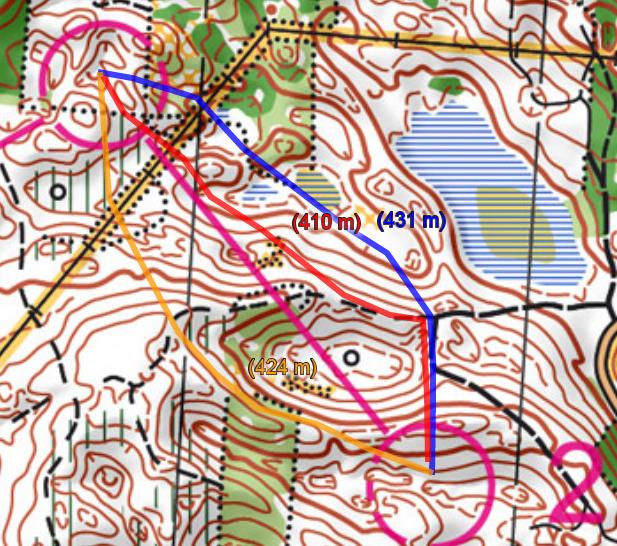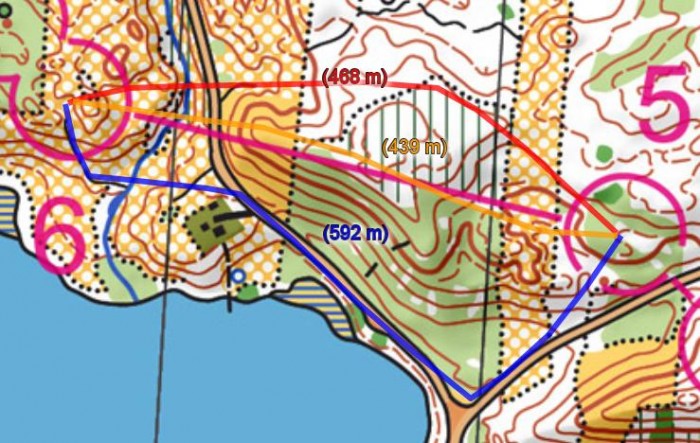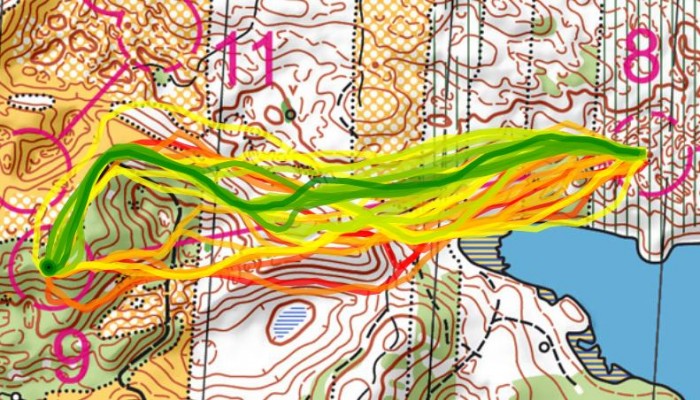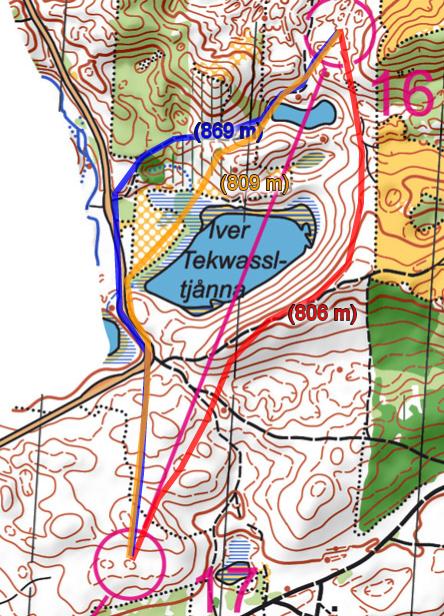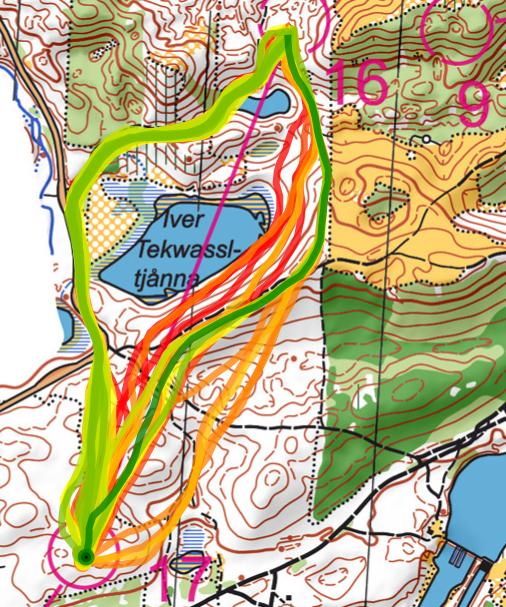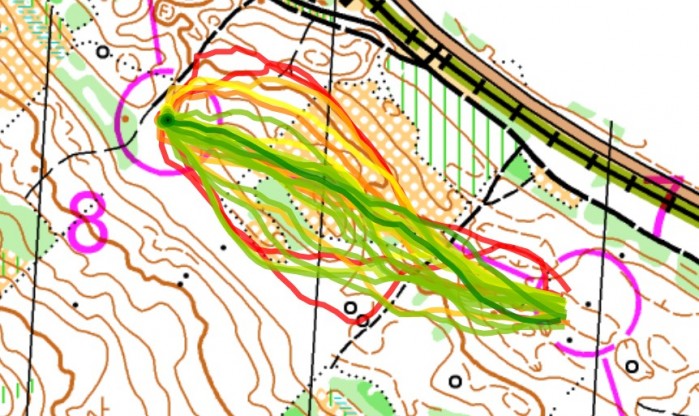A tough long distance with many long legs with route choice options – that were some of the ingredients in today’s long distance final at the European Championships in Skattungbyn, Sweden.
An important note about the illustrations: All time on the illustrations are GPS-times, i.e. not official split times. Thus time may be off by 5-10 seconds in some cases. For statistical analysis with many runners like presented in most of the illustrations, these offsets are considered to be not significantly alter the overall analysis in most cases. However, there may be cases where the conclusion could be slightly altered by using actual split times. Please add a comment below if you spot such cases, and the article will be updated accordingly.
This article is part of the EOC 2012 GPS-analysis series. In a cooperation with the EOC 2012organizers, World of O/O-training.net will do GPS-analysis after each of the EOC races in Sweden the coming week.
Analysis done in 2DRerun
The analysis in done using 2DRerun. You can make your own analysis of the EOC long distance in 2DRerun using the links above (note! long loading time as many routes must be loaded).
As a background for this article, you can use the map without any routes drawn – see the men’s map here and the women’s map here.
Men 2-3
The men’s course started with two short, technical legs before heading off on the first route choice leg to control number three:

The leg to number three offered three main route choices – direct (around 1 km), left (around 50 meters longer) and right (around 150 meter longer than the direct choice). The direct route gave you a lot of marsh-running – the marshes being quite wet in this area. The right route gave you 150 meter on a road and 400 meter of a path – thus allowing you to hold higher speed than on the alternatives.
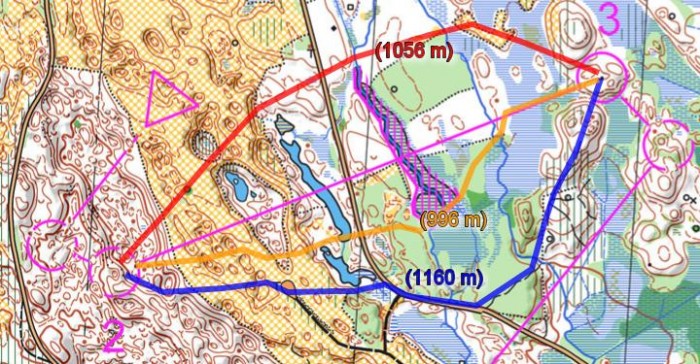
Based on the routes run (see below), most of the good times are run to the right. There is also significantly less variance in the times, i.e. few poor times – a clear indication that the risk is lower on this route. On the other hand, the best time run on the left route is not much slower than the best time on the right route. Here both gold and silver medalists Lundanes and Merz went left. Novikov started out left, then changed his mind and went left. This lost him more time than would have been lost by just continuing right…
Men A-final: 2-3 (Legtimes)
| 1. |
Ionut Alin Zinca |
5:56 |
+0:00 |
| 2. |
Fredrik Johansson |
5:58 |
+0:02 |
| 3. |
Audun Hultgreen Weltzien |
6:10 |
+0:14 |
| 4. |
Edgars Bertuks |
6:13 |
+0:17 |
| 5. |
Mikhail Mamleev |
6:14 |
+0:18 |
| 6. |
Jan Prochazka |
6:14 |
+0:18 |
| 7. |
Frédéric Tranchand |
6:14 |
+0:18 |
| 8. |
Olav Lundanes |
6:16 |
+0:20 |
| 9. |
Milos Nykodym |
6:18 |
+0:22 |
| 10. |
Matthias Merz |
6:21 |
+0:25 |
| 12. |
Valentin Novikov |
6:24 |
+0:28 |
Even if loosing time on number three, Lundanes is in the lead at control 3 due to a very good start in the two first legs:
Men A-final: 2-3 (Total times)
| 1. |
Olav Lundanes |
9:29 |
+0:00 |
| 2. |
Mikhail Mamleev |
9:35 |
+0:06 |
| 3. |
Matthias Merz |
9:41 |
+0:12 |
| 4. |
Ionut Alin Zinca |
9:47 |
+0:18 |
| 5. |
Edgars Bertuks |
9:49 |
+0:20 |
| 6. |
Anders Nordberg |
9:52 |
+0:23 |
| 7. |
Gernot Kerschbaumer |
9:52 |
+0:23 |
| 8. |
Valentin Novikov |
9:52 |
+0:23 |
| 9. |
Matthias Müller |
9:54 |
+0:25 |
| 10. |
Oleksandr Kratov |
9:58 |
+0:29 |

Men 4-5
The next long leg was the leg from number 4 to number 5. This was a longer leg – but with less distinct route choices. Still it proved to be a leg which made a difference on the top of the results list.

There are basically three main alternatives – direct (blue above) which is the shortest run by Lundanes. Left (red above, run by Novikov) which exploits a small path on part of the leg – paying with another 40-50 meters of running and right (orange above, run by Lauenstein) which has some road and path running – but being around 100 meters longer.
As you see from the comparisons below, the right variant takes you too far from the line without giving significantly better runnability – the runners are parallell when Lauenstein leaves the path, but Lauenstein then has further to run to the control.
The left and direct variants are very equal – the last part into the control is what makes the difference between Lundanes and Novikov.


Men A-final: 4-5 (Legtimes)
| 1. |
Valentin Novikov |
7:36 |
+0:00 |
| 2. |
Anders Nordberg |
7:49 |
+0:13 |
| 3. |
Olav Lundanes |
7:50 |
+0:14 |
| 4. |
Matthias Merz |
7:54 |
+0:18 |
| 5. |
Johan Runesson |
7:54 |
+0:18 |
| 6. |
Oleksandr Kratov |
7:57 |
+0:21 |
| 7. |
Marc Lauenstein |
7:59 |
+0:23 |
| 8. |
Olle Kärner |
8:00 |
+0:24 |
| 9. |
Martins Sirmais |
8:04 |
+0:28 |
| 10. |
Fredrik Johansson |
8:07 |
+0:31 |
Men A-final: 4-5 (Total times)
| 1. |
Olav Lundanes |
18:20 |
+0:00 |
| 2. |
Valentin Novikov |
18:32 |
+0:12 |
| 3. |
Matthias Merz |
18:41 |
+0:21 |
| 4. |
Anders Nordberg |
18:47 |
+0:27 |
| 5. |
Oleksandr Kratov |
19:00 |
+0:40 |
| 6. |
Fredrik Johansson |
19:13 |
+0:53 |
| 7. |
Gernot Kerschbaumer |
19:13 |
+0:53 |
| 8. |
Martins Sirmais |
19:16 |
+0:56 |
| 9. |
Dmitry Tsvetkov |
19:18 |
+0:58 |
| 10. |
Mikhail Mamleev |
19:20 |
+1:00 |
This leg from 4 to 5 is one of the deciding legs in the race – already here we have Lundanes, Novikov and Merz on top of the results list. These three also run 3 of the 4 best times on the leg.

Men 5-6
The leg from 5-6 gave a surprisingly wide spreading of routechoices – considering that there is fairly good runnability and relatively easy orienteering when staying close to the line. Below the main alternatives run are drawn. The around 20 top times are run on the three most direct variants – which vary only little in length.

Men A-final: 5-6 (Legtimes)
| 1. |
Olav Lundanes |
6:02 |
+0:00 |
| 2. |
Anders Nordberg |
6:06 |
+0:04 |
| 3. |
Scott Fraser |
6:10 |
+0:08 |
| 4. |
Valentin Novikov |
6:11 |
+0:09 |
| 5. |
Matthias Kyburz |
6:11 |
+0:09 |
| 6. |
Gustav Bergman |
6:11 |
+0:09 |
| 7. |
Topi Anjala |
6:11 |
+0:09 |
| 8. |
Frédéric Tranchand |
6:12 |
+0:10 |
| 9. |
Hans Gunnar Omdal |
6:16 |
+0:14 |
| 10. |
Jani Lakanen |
6:16 |
+0:14 |
| 33. |
Matthias Merz |
6:53 |
+0:51 |
Fastest of all is Lundanes with a combination of the red and yellow variant – ahead of Nordberg who runs the blue variant. Novikov runs the red variant. At this leg Merz does a big routechoice error – running at the northern side of the lake (purple alternative) – loosing more than 50 seconds to Lundanes (could this be a direction error and not a pure routechoice error?). This is a very decisive point in the race. This northern routechoice gives some more path running, but as you can see, the runnability on Merz’s route at the north side of the lake is poorer than at the south side of the lake – especially in the rocky area.


Men A-final: 5-6 (Total times)
| 1. |
Olav Lundanes |
24:22 |
+0:00 |
| 2. |
Valentin Novikov |
24:43 |
+0:21 |
| 3. |
Anders Nordberg |
24:53 |
+0:31 |
| 4. |
Oleksandr Kratov |
25:21 |
+0:59 |
| 5. |
Matthias Merz |
25:34 |
+1:12 |
| 6. |
Dmitry Tsvetkov |
25:38 |
+1:16 |
| 7. |
Martins Sirmais |
25:38 |
+1:16 |
| 8. |
Hans Gunnar Omdal |
25:40 |
+1:18 |
| 9. |
Gernot Kerschbaumer |
25:46 |
+1:24 |
| 10. |
Mikhail Mamleev |
25:54 |
+1:32 |
At this point in the race Merz has lost the initiative – and is more than a minute behind Lundanes in 5th. Lundanes is holding on to his lead – 21 seconds ahead of Novikov. Nordberg has the bronze position at this point.
Men 7-8
After control 7 the course changes characteristics – from the open, rather flat and stony terrain to hilly terrain with wet marshes. The leg from control 7 to control 8 is a leg where steep hills and marshes are obstacles on the way – forcing the runners to make a choice: Either climb the hill / wade through the marsh – or run around. The runners have not run many marshes yet in this race, and have thus not complete knowledge about how much slower the marshes are. There are some small paths a the middle of the leg which can be used to potentially increase the speed and make the orienteering easier, but these paths are not very good.
There are a number of alternatives (see below) – with lengths ranging from around 900 meter for the straightest route to around 1000 meters for the longest of the drawn routes (left, light blue). Based on a statistical analysis, you can simplified say that the straighter/shorter you run, the faster you are. Novikov is fastest ahead of Lundanes – both running straight/right variants (close to the red alternative below). Merz again looses more than 20 seconds by choosing a non-optimal route – loosing most of the time on the last part of the leg (see illustration below).

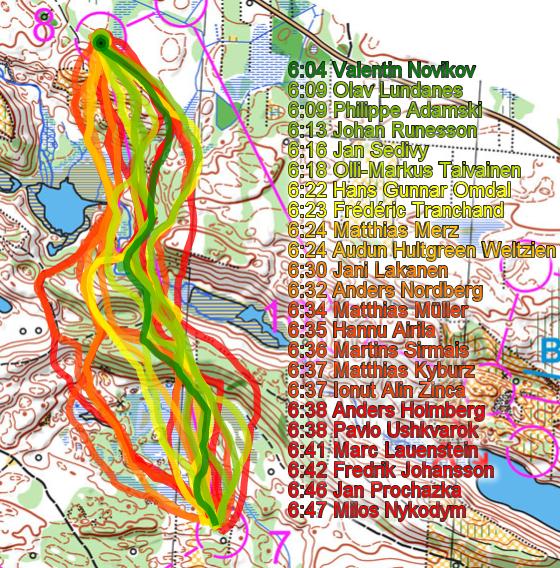

Men A-final: 7-8 (Legtimes)
| 1. |
Valentin Novikov |
6:07 |
+0:00 |
| 2. |
Olav Lundanes |
6:12 |
+0:05 |
| 3. |
Philippe Adamski |
6:13 |
+0:06 |
| 4. |
Johan Runesson |
6:15 |
+0:08 |
| 5. |
Olli-Markus Taivainen |
6:18 |
+0:11 |
| 6. |
Frédéric Tranchand |
6:23 |
+0:16 |
| 7. |
Hans Gunnar Omdal |
6:25 |
+0:18 |
| 8. |
Audun Hultgreen Weltzien |
6:25 |
+0:18 |
| 9. |
Jan Sedivy |
6:28 |
+0:21 |
| 10. |
Matthias Merz |
6:31 |
+0:24 |
Men A-final: 7-8 (Total times)
| 1. |
Olav Lundanes |
32:15 |
+0:00 |
| 2. |
Valentin Novikov |
32:26 |
+0:11 |
| 3. |
Anders Nordberg |
33:38 |
+1:23 |
| 4. |
Matthias Merz |
33:42 |
+1:27 |
| 5. |
Martins Sirmais |
34:14 |
+1:59 |
| 6. |
Johan Runesson |
34:17 |
+2:02 |
| 7. |
Philippe Adamski |
34:19 |
+2:04 |
| 8. |
Hans Gunnar Omdal |
34:26 |
+2:11 |
| 9. |
Gernot Kerschbaumer |
34:28 |
+2:13 |
| 10. |
Oleksandr Kratov |
34:34 |
+2:19 |
Novikov gets even closer to Lundanes at this point – now being only 11 seconds behind – while Merz now is 1:27 behind. Swedish Runesson had a few good legs and is up at 6th place.
Men 8-18 (including forking part)
In the forking part Lundanes takes around 20-30 seconds on Novikov and Merz. Now the gap down to Novikov is at 36 seconds – nearly two minutes down to Merz.
Men A-final: 18. (Total times)
| 1. |
Olav Lundanes |
46:51 |
+0:00 |
| 2. |
Valentin Novikov |
47:27 |
+0:36 |
| 3. |
Anders Nordberg |
48:41 |
+1:50 |
| 4. |
Matthias Merz |
48:43 |
+1:52 |
| 5. |
Martins Sirmais |
49:46 |
+2:55 |
| 6. |
Oleksandr Kratov |
50:05 |
+3:14* |
| 7. |
Johan Runesson |
50:11 |
+3:20* |
| 8. |
Frédéric Tranchand |
50:26 |
+3:35* |
| 9. |
Hans Gunnar Omdal |
50:28 |
+3:37* |
| 10. |
Pavlo Ushkvarok |
50:31 |
+3:40* |

Men 18-19
The men’s leg 18-19 is the leg where Lundanes looses most time in this race – by fighting straight (red route below) instead of using one of the alternatives around with better runnability and less hills. The northern route of Merz and Lauenstein is the fastest (green below) – exploiting the path at the north edge of the control and also saving some height compared to the direct route of Lundanes. The southern choice also has significant parts of path running. The third illustration below shows this difference in speed on the path/road compared to Lundanes in the hilly terrain.



Men A-final: 18-19 (Legtimes)
| 1. |
Marc Lauenstein |
6:48 |
+0:00 |
| 2. |
Matthias Merz |
6:50 |
+0:02 |
| 3. |
Anders Nordberg |
6:53 |
+0:05 |
| 4. |
Hans Gunnar Omdal |
6:53 |
+0:05 |
| 5. |
Philippe Adamski |
6:53 |
+0:05 |
| 6. |
Valentin Novikov |
6:56 |
+0:08 |
| 7. |
Oleksandr Kratov |
6:58 |
+0:10 |
| 8. |
Audun Hultgreen Weltzien |
6:58 |
+0:10 |
| 9. |
Gustav Bergman |
6:58 |
+0:10 |
| 10. |
Pavlo Ushkvarok |
7:02 |
+0:14 |
| 16. |
Olav Lundanes |
7:16 |
+0:28 |
Here the different variants on the leg are shown.

Men A-final: 18-19 (Total times)
| 1. |
Olav Lundanes |
54:07 |
+0:00 |
| 2. |
Valentin Novikov |
54:23 |
+0:16 |
| 3. |
Matthias Merz |
55:33 |
+1:26 |
| 4. |
Anders Nordberg |
55:34 |
+1:27 |
| 5. |
Oleksandr Kratov |
57:03 |
+2:56 |
| 6. |
Hans Gunnar Omdal |
57:21 |
+3:14 |
| 7. |
Marc Lauenstein |
57:24 |
+3:17 |
| 8. |
Pavlo Ushkvarok |
57:33 |
+3:26 |
| 9. |
Philippe Adamski |
57:40 |
+3:33 |
| 10. |
Martins Sirmais |
57:46 |
+3:39 |
Lundanes keeps his lead after this bad routechoice – but the lead is now reduced to 16 seconds. Merz eats up nearly half a minute – and takes back the third position from Nordberg.
Men 21-22
The leg from 21 to 22 does not offer so big route choice alternatives – but is still a bad leg for both Lundanes and Novikov who loose 24 and 39 seconds to Merz, respectively. The trick on this leg is to keep close to the line on the first part of the leg (as there is not much to earn with respect to runnability with moving away from the line), and exploiting the paths in the seconds part of the leg.

A slight left alternative is the fastest here. Both Lundanes and Novikov loose time by running too far to the north at the first part of the leg as you can see from the illustrations below.
Men A-final: 21-22 (Legtimes)
| 1. |
Matthias Merz |
7:46 |
+0:00 |
| 2. |
Martins Sirmais |
7:47 |
+0:01 |
| 3. |
Hans Gunnar Omdal |
7:49 |
+0:03 |
| 4. |
Marc Lauenstein |
7:51 |
+0:05 |
| 5. |
Frédéric Tranchand |
7:53 |
+0:07 |
| 6. |
Jan Sedivy |
8:02 |
+0:16 |
| 7. |
Dmitry Tsvetkov |
8:05 |
+0:19 |
| 8. |
Anders Nordberg |
8:08 |
+0:22 |
| 9. |
Jani Lakanen |
8:08 |
+0:22 |
| 10. |
Olav Lundanes |
8:10 |
+0:24 |
| 21. |
Valentin Novikov |
8:25 |
+0:39 |

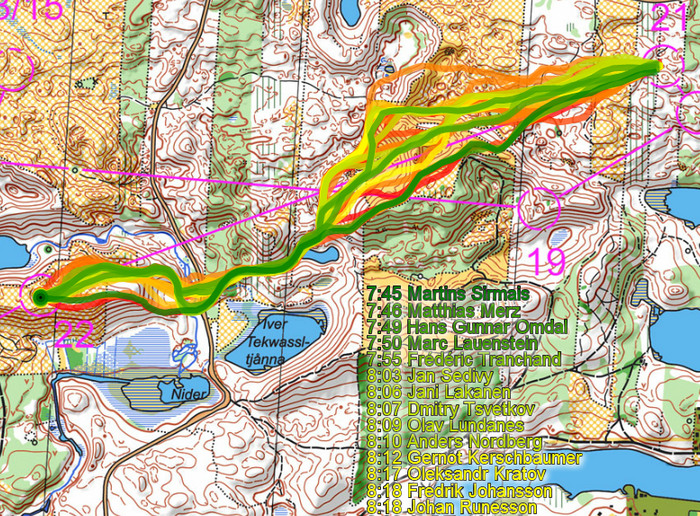
Men A-final: 21-22 (Total times)
| 1. |
Olav Lundanes |
65:33 |
+0:00 |
| 2. |
Valentin Novikov |
66:13 |
+0:40 |
| 3. |
Matthias Merz |
66:41 |
+1:08 |
| 4. |
Anders Nordberg |
67:17 |
+1:44 |
| 5. |
Marc Lauenstein |
68:43 |
+3:10 |
| 6. |
Hans Gunnar Omdal |
68:47 |
+3:14 |
| 7. |
Oleksandr Kratov |
68:51 |
+3:18 |
| 8. |
Martins Sirmais |
69:08 |
+3:35 |
| 9. |
Pavlo Ushkvarok |
69:18 |
+3:45 |
| 10. |
Philippe Adamski |
69:31 |
+3:58 |
Looking at the overall, Merz is suddenly down at 1:08 behind (down from 1:52 after the forking) – whereas Novikov is at 40 seconds behind Lundanes. Nordberg is still fighting for a medal – 1:44 behind Lundanes. Down to Lauenstein in 4th there is 3:10. Lauenstein has slowly been getting closer on the last legs – being famous for his strong finishes in long distance races.
Men 22-23
The leg from 21 to 22 was the last long leg in the race. Two shorter routechoice legs from 22-23 and 23-24 were offered before the physically hard finish of the race.

The leg from 22-23 does not give very big time differences, but it still seems clear from the split times that a northern variant is fastest – a few seconds faster than the direct variant of Novikov and Merz and the combination of northern/direct of Lundanes. THe southern variant of Bergman is far too long.
Men A-final: 22-23 (Legtimes)
| 1. |
Anders Nordberg |
3:45 |
+0:00 |
| 2. |
Dmitry Tsvetkov |
3:46 |
+0:01 |
| 3. |
Valentin Novikov |
3:50 |
+0:05 |
| 4. |
Olav Lundanes |
3:54 |
+0:09 |
| 5. |
Matthias Merz |
3:54 |
+0:09 |
| 6. |
Marc Lauenstein |
3:55 |
+0:10 |
| 7. |
Yuryj Tambasov |
3:55 |
+0:10 |
| 8. |
Oleksandr Kratov |
3:56 |
+0:11 |
| 9. |
Gernot Kerschbaumer |
3:57 |
+0:12 |
| 10. |
Edgars Bertuks |
3:57 |
+0:12 |

Men A-final: 22-23 (Total times)
| 1. |
Olav Lundanes |
69:27 |
+0:00 |
| 2. |
Valentin Novikov |
70:03 |
+0:36 |
| 3. |
Matthias Merz |
70:35 |
+1:08 |
| 4. |
Anders Nordberg |
71:02 |
+1:35 |
| 5. |
Marc Lauenstein |
72:38 |
+3:11 |
| 6. |
Oleksandr Kratov |
72:47 |
+3:20 |
| 7. |
Hans Gunnar Omdal |
73:07 |
+3:40 |
| 8. |
Philippe Adamski |
73:32 |
+4:05 |
| 9. |
Martins Sirmais |
73:42 |
+4:15 |
| 10. |
Pavlo Ushkvarok |
73:55 |
+4:28 |
In the overall a few more seconds earned for Novikov – now down at only 36 seconds lead for Lundanes.
Men 24-25
The leg from 24 to 25 is a classical “left or right around the lake” leg – which suprisingly both Lundanes and Merz got wrong. The right side is shorter – but the left is faster due to more path running.

The 7 best times are run to the north here – with Merz and Lundanes at 8th and 9th going south. It is probably 8-9 seconds faster to go north.

Men A-final: 24-25 (Legtimes)
| 1. |
Philippe Adamski |
2:57 |
+0:00 |
| 2. |
Valentin Novikov |
2:58 |
+0:01 |
| 3. |
Marc Lauenstein |
2:58 |
+0:01 |
| 4. |
Martins Sirmais |
2:58 |
+0:01 |
| 5. |
Matthias Müller |
3:03 |
+0:06 |
| 6. |
Anders Holmberg |
3:04 |
+0:07 |
| 7. |
Aleksei Alekseyonok |
3:04 |
+0:07 |
| 8. |
Matthias Merz |
3:05 |
+0:08 |
| 9. |
Olav Lundanes |
3:06 |
+0:09 |
| 10. |
Dmitry Tsvetkov |
3:06 |
+0:09 |
Men A-final: 24-25 (Total times)
| 1. |
Olav Lundanes |
73:57 |
+0:00 |
| 2. |
Valentin Novikov |
74:27 |
+0:30 |
| 3. |
Matthias Merz |
75:04 |
+1:07 |
| 4. |
Anders Nordberg |
75:36 |
+1:39 |
| 5. |
Marc Lauenstein |
76:59 |
+3:02 |
| 6. |
Oleksandr Kratov |
77:29 |
+3:32 |
| 7. |
Hans Gunnar Omdal |
77:49 |
+3:52 |
| 8. |
Philippe Adamski |
78:00 |
+4:03 |
| 9. |
Martins Sirmais |
78:11 |
+4:14 |
| 10. |
Dmitry Tsvetkov |
78:38 |
+4:41 |
With Novikov going north and Lundanes south, Lundanes’s lead has shrunk to only 30 seconds ahead of the physically tough finish! Merz is 1:07 down on Lundanes.
Last part
The last part is mostly physical - the tough finish costing Novikov the silver medal which he has had in his pocket for more than an hour. Merz is strong – coming up in second spot.

Men A-final: 32-33 (Total times)
| 1. |
Olav Lundanes |
87:25 |
+0:00 |
| 2. |
Matthias Merz |
88:27 |
+1:02 |
| 3. |
Valentin Novikov |
88:53 |
+1:28 |
| 4. |
Anders Nordberg |
89:42 |
+2:17 |
| 5. |
Marc Lauenstein |
90:29 |
+3:04 |
| 6. |
Oleksandr Kratov |
92:18 |
+4:53 |
| 7. |
Philippe Adamski |
92:35 |
+5:10 |
| 8. |
Dmitry Tsvetkov |
92:37 |
+5:12 |
| 9. |
Hans Gunnar Omdal |
92:54 |
+5:29 |
| 10. |
Frédéric Tranchand |
93:19 |
+5:54 |
Lundanes versus Merz
Below you see an AutOanalysis between gold medalist Olav Lundanes and silver medalist Matthias Merz. In the AutOanalysis you can clearly see the conclusions drawn above – with Merz loosing time on the routechoices to 6 and 8, and Lundanes loosing time on the route choice to 19 and 22. Also note hhow fast Merz is in the lower part of the small last loop.
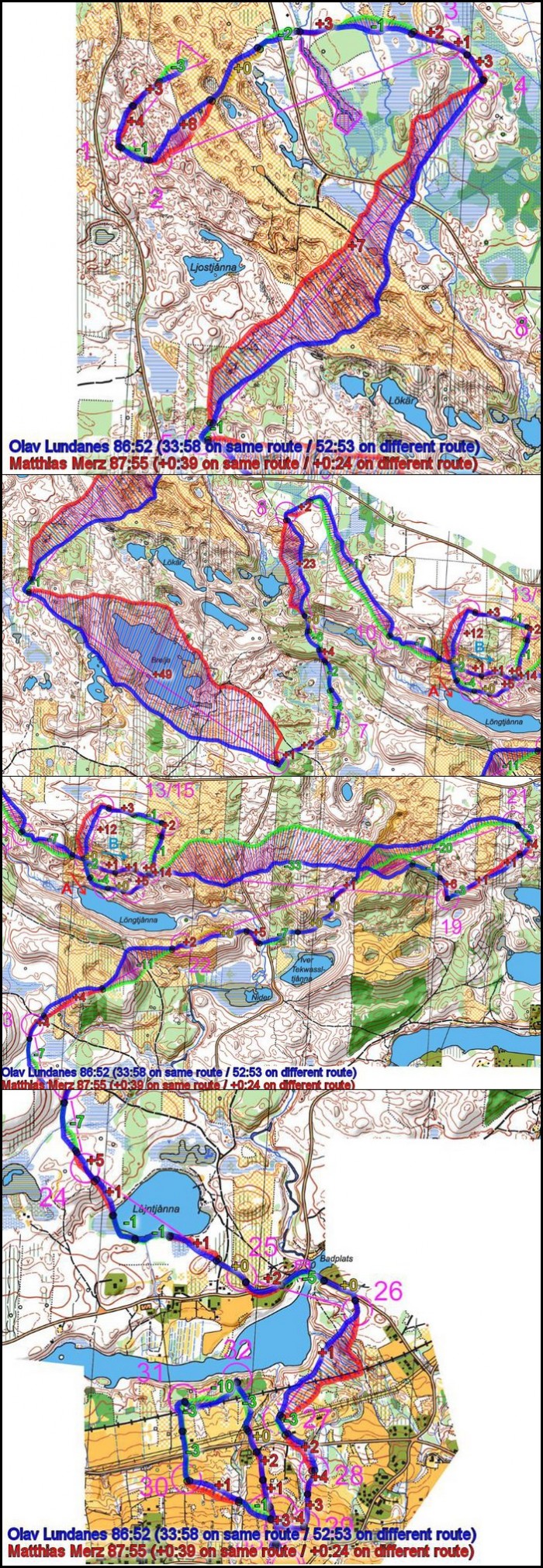
Lundanes versus Novikov
Here also the AutOanalysis between Lundanes and Novikov. There is no segment with more than 12 seconds difference between Novikov and Lundanes! Very close races. Lundanes wins because he is stronger in the end and does slightly fewer of the small errors than Novikov does.

Women’s race
For the women’s race no full analysis is given, but illustrations are included. Simone Niggli is the fastest on most legs – winning 15 of 24 legs – loosing only 14 seconds to “Superwomen” until she got the message that she will win the race at the spectator control.


Niggli versus Riabkina
Comparing Niggli versus Riabkina gives a lot of red numbers in the autOanalysis – Niggli has simply been running faster all the way (except when Niggli and Riabkina were together for some controls). Therefore a second autOanalysis is also included (below the first one) where all times in Riabkina’s and Niggli’s routes are adjusted by the overall difference between them. Then it is possible to see more clearly in which parts of the race Niggli looses some time compared to Riabkina when adjusting for the difference in running speed. Relatively seen Niggli opens quite “slow” to the first control – as she also said in her interview. Then she has an amazing speed until control 3. Generally Niggli is very strong in the hills – both up and down.
The only bad long leg for Niggli is the leg from 9 to 10 were she relatively seen looses some 20 seconds (although she is just as fast as Riabkina).
Riabkina looses some time around the 8th and 9th control – and also to control 18 and in the uphill in the end.


Women 2-3
The left side of the lake seems faster – and is also run by most runners.

Women 4-5
The same leg as the men – and the same routes are the fastest: Direct variants!

Women 7-8
Again the fastest is to keep close to the line. Niggli crushes the others on this leg.

Women 9-10

Women 12-13

Thanks to Johan Fegar for very good help with making figures ! The analysis is made using 2DRerun/3DRerun.









































